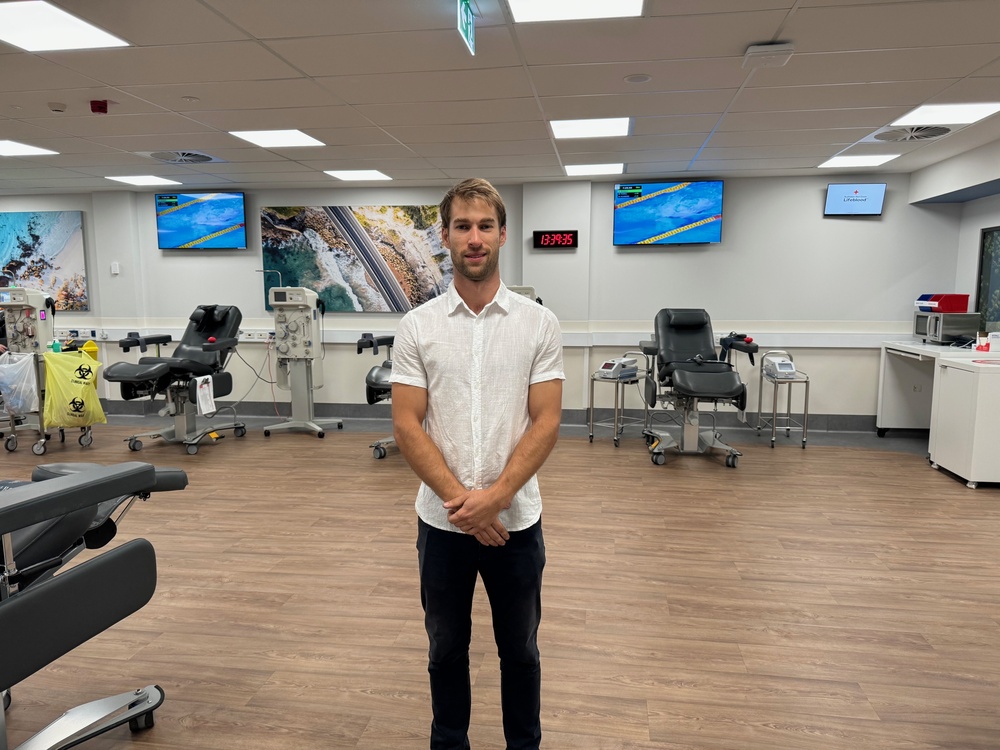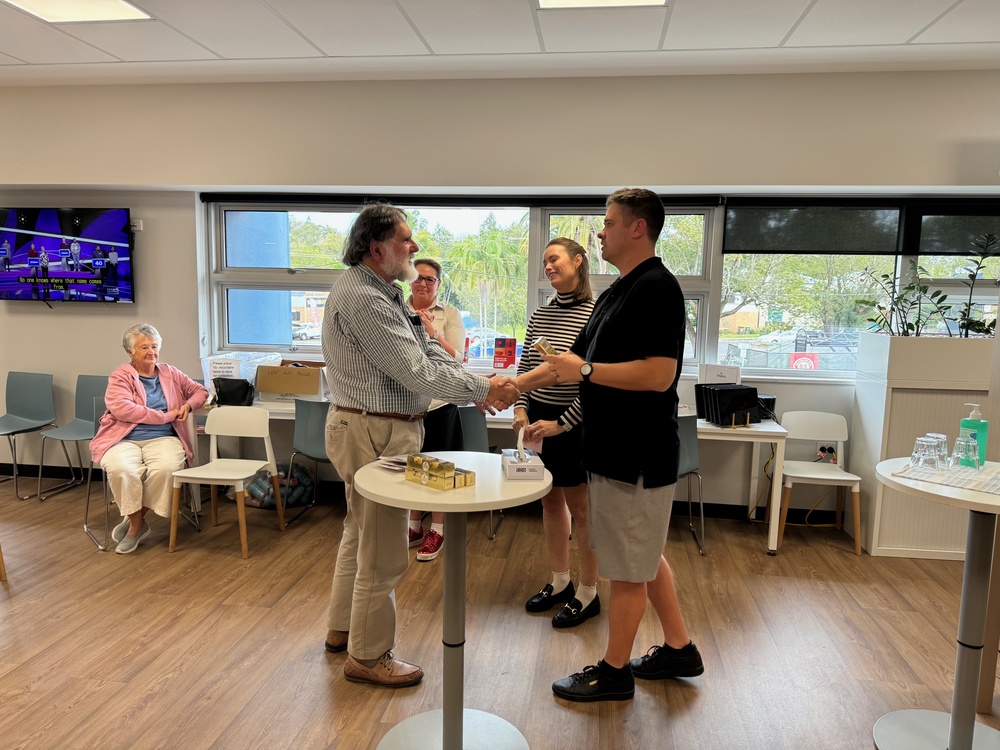Lifeblood celebrates 16 locals for over 300 blood and plasma donations each
Simon Mumford
16 June 2024, 9:00 PM
 The sixteen milestone donors and Lismore Lifeblood staff
The sixteen milestone donors and Lismore Lifeblood staffLast week was National Blood Donor Week. The Lismore Blood Donor Centre staff on Bounty Street were all smiles as blood and plasma donors poured in through the doors.
On Friday, they celebrated local donors who reached the 300 and 400 clubs as part of an annual recognition milestone celebration.
That's right. 16 donors have donated blood and plasma over 300 times, for a total of over 4,500 donations. Of those donations, they helped save the lives of over 13,500 recipients.
Local legends like Ken Clarke, Jeff East, Duncan Raymont, Jeffrey Phillips, Jarvis Ben-Allan and Mark Youngberry.

(Jeff East and Ken Clark have over 700 blood and plasma donations between them)
Ken Clarke started donating blood when he was 18 and has amassed 425 donations in the last 42 years. His father was a blood donor; that was Ken's initial motivation, but then his father died of a heart attack at 48.
"I thought I'd try and kind of carry on from what he was doing," Ken said. Ken donates plasma every two weeks.
Jeff East has a similar story. He started donating at 18 because his mother was a donor. She also died at a young age, 42. Jeff's donated blood and plasma 366 times.
"I was working all the time in the early days, so I have donated about 60 odd bloods and 300 odd plasmas."
Most of the people who were being celebrated are older, say 50 plus. To demonstrate that age is not a factor in reaching the 300 donation milestone, 32 year old Jarvis Ben-Allan told his story.
"I started at 16 (the age limit has since increased to 18). I was in high school, and they said who wants to come and donate blood? A couple of mates thought we could get out of school, so that's how we started. Some continued, some didn't, and some fainted. It's been a bit of a habit ever since."
Jarvis has reached 312 donations at his young age. Apparently, the national record is just over 1,000 donations, something that Jarvis and the staff at Lismore joke about him reaching and surpassing because of his age.
"I think I worked out by my mid-60's I should get there if I continue the way I am going," Jarvis said.

(Jarvis Ben-Allan has chalked up over 300 donations at the age of 32)
As mentioned at the start of this story, these sixteen people have helped save the lives of over 13,500 recipients. One of those recipients is young Archer Birmingham.
Matt and Claire Birmingham bravely shared their story about Archer, who was diagnosed with acute lymphoblastic leukaemia a week after his third birthday. Archer went through almost three years of treatment, which coincided with Covid.
Claire said that Archer received nineteen transfusions of blood products, seven packed cells (red blood cells) and 12 platelets (for clotting) before they even had a confirmed diagnosis.
"He had multiple transfusions before he was able to be transported to hospital," Claire explained, "And they actually told us at the time of diagnosis that had we taken him home and put him to bed that night, he probably would have passed away because his hemoglobin was so low that his heart would have stopped."

(Claire and Matt Birmingham share their story at Lismore Lifeblood last Friday)
Unfortunately, both Matt and Claire did not match Archer's blood type. Archer was a universal O-negative blood type, and during this time, there were often shortages of blood supply due to the fact that type O blood groups are used by the majority of the population. O-negative blood can be used in transfusions for any blood type.
'He would often have to wait longer than we would have liked or longer than they advised to have blood transfusions. Normally, they transfused kids at around 70 hemoglobin, they'd often leave him to the 50s because he has a more universal blood type, and that was often less available for him."
"It's a really awful feeling to be so helpless and not be able to help your kid, not that we could ever directly donate to him anyway, but to not be able to contribute to restocking those supplies was really confronting," Claire said.
In response, Matt and Claire set up an Archer Lifeblood team to recruit as many family, friends and acquaintances to donate blood and plasma.
"Thank you all, because you probably, at some point, very directly helped save our boy's life. And that is huge for us, so thank you," Claire told the donor milestone celebrants.
Matt added, "I know you've probably got your own reasons for doing it (donating), a family member is sick or a friend or you know someone or you're just genuinely nice people who care for the community. On behalf of us, thank you so much.
"It is incredible to watch your son pale, not being able to move and not being able to talk. As soon as that blood hits him, it's a light; it changes him in a second." Claire chimes in with, "Actually, 59 minutes," to much laughter.
"He would be grumpy, grizzly and scream at everyone, and then the blood would hit him, and he sparks back to life. Then you just face the next challenge."
Matt and Claire explained that Archer, who is turning 8 in November, is a typical 7-year-old boy. Four weeks after starting chemotherapy treatment, Archer was in remission. His last blood transfusion was in 2021, and he has not had any treatment since 2022.
Life has changed a great deal from Archer's first diagnosis for Matt and Claire. However, statistically, the chance of a relapse is high, which means a constant worry that a secondary cancer may form.
"I personally struggle to trust it. I have to consciously remind myself to expect the best because we've watched so many people around us relapse. It's a self-preservation thing, where you know you get caught off guard once, and it rocks you like you can't imagine. I don't really want to feel like that again. It's a terrible mindset to have, but if you expect the worst, it's not going to hit you as badly.
"We make a really conscious effort to appreciate every day that we have with him, but we are by no means under the illusion that it's all over. He has ongoing medical challenges, and the harsh reality is that childhood cancer survivors are 80% more likely than the rest of us to develop secondary cancer before they're 40. So, we feel that we are preparing ourselves for potential future complications. But we obviously appreciate everything we've got."
Hearing Matt and Claire's story about their journey with Archer and the constant worry that is ahead of them makes you appreciate what the sixteen milestone donors have achieved and the lives that they have saved.

(Lismore's leading donor is Duncan Raymont, with 450 donations. Each donor over the 300 mark received a small award from Claire and Matt Birmingham)
The Lismore App is a supporter of Lifeblood for the very reason you have read from Matt and Claire. Helen Sager, who hosted the event, and spokesperson Scott Morrison said the need for new donors and more blood and plasma donations continues.
If you can spare one hour a month, you can donate blood. If you can spare 90 minutes, you can donate plasma. If you have more time, you can donate plasma every two weeks. One donor even said she uses the time as 'me time'. Time to get some quiet, get a milkshake and rest for an hour.
Visit the website at www.lifeblood.com.au or pop in and talk to Helen and the team at Level 1/26 Bounty Street, Lismore (just down from the Town Hall) if you have questions about whether you can be a donor.

